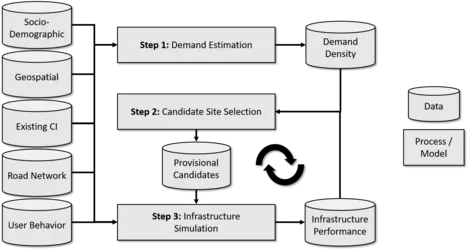Data-based Analysis and Design of Public Charging Infrastructure for Battery Electric Vehicles
Contact: Lennart Adenaw, M. Sc.

Problem Statement
Politicians, scientists and environmentalists have identified electromobility as a key technology on the path toward a sustainable transportation sector. The replacement of privately owned internal combustion engine vehicles (ICEV) with battery electric vehicles (BEV) is a major aspect of a successful traffic electrification all over the world. Hence, policymakers push to accelerate BEV adoption rates by means of subsidies, tax reductions, organizational privileges and programs facilitating the fast and pervasive buildup of charging infrastructure (CI) for BEV.
Especially in urban environments, where there is little space for privately owned CI, BEV users heavily rely on public CI. Consequentially, large volumes of public CI are needed to attain a significant BEV market penetration in urban areas.
The design of CI comprises many aspects, of which the location choice is one of the most fundamental decisions, because it directly influences the interaction between users and CI and the extend to which charging can benefit into existing geospatial mobility patterns.
Hence, decision-makers require models and tools helping them to choose optimal charging sites in accordance with the expected charging demand. To date, there is a lack of such models and tools, especially when it comes to the large-scale deployment of public charging infrastructure.
Objective
In this project, a framework of tools for the optimal positioning and dimensioning of charging points for public, inner-city spaces is to be developed. This framework should be able to consider various future scenarios and use input data that is both free and available in wide areas.
Realization
- Analysis of existing CI
- Deduction of best practices for CI positioning
- Development of a method for the automatized analysis of a site's installation potential
- Simulation of CI
- Opimization of CI